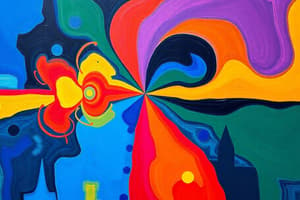Podcast
Questions and Answers
What are the five senses of a human being?
What are the five senses of a human being?
Eye, ear, nose, skin, and tongue
What does the pupil do?
What does the pupil do?
- Absorbs light waves
- Controls the amount of light entering the eye (correct)
- Bends and focuses light waves
- Allows light waves to pass into the eye (correct)
What is the function of the iris?
What is the function of the iris?
Controls the amount of light that enters the eye
The image on the retina is upright and direct.
The image on the retina is upright and direct.
What is transduction in the context of the eye?
What is transduction in the context of the eye?
What are the three tiny bones in the middle ear called?
What are the three tiny bones in the middle ear called?
The cochlea contains receptors for smell.
The cochlea contains receptors for smell.
What is motion sickness caused by?
What is motion sickness caused by?
What are the five tastes detected by taste buds?
What are the five tastes detected by taste buds?
What do kinesthetic senses inform us about?
What do kinesthetic senses inform us about?
Study Notes
Sensation
- Sensation is the process of receiving information from our environment through our senses.
- Our five senses are sight, hearing, smell, touch, and taste.
Structure and Function of the Eye
- Light enters the eye through the cornea, a transparent covering that protects the eye.
- The pupil, a small opening in the center of the eye, allows light to pass through.
- The iris, the colored part of the eye, controls the amount of light entering by contracting or dilating.
- The lens, a transparent structure, focuses light onto the retina.
- This process of focusing light is called visual accommodation.
- The retina, located at the back of the eye, contains photoreceptor cells that absorb light waves.
Visual Pathways: Eye to Brain
- Light waves travel from the retina, through the optic nerve, to the occipital lobe of the brain.
- The occipital lobe contains the primary visual cortex, which transforms nerve impulses into basic visual sensations.
- The primary visual cortex sends impulses to neighboring visual association areas, which add meaning to the sensations.
Audition
- Sound waves enter the outer ear (pinna).
- The waves travel through the auditory canal to the eardrum, causing it to vibrate.
- Vibrations are passed to the ossicles, three tiny bones in the middle ear: the hammer, anvil, and stirrup.
- The ossicles amplify vibrations and pass them to the oval window, which connects to the cochlea.
- The cochlea contains hair cells that perform transduction, transforming vibrations into nerve impulses sent to the brain.
Vestibular Sense
- Located in the inner ear, the vestibular sense helps maintain balance and tracks head position.
- An infection of the vestibular sense can cause dizziness, nausea, and balance issues.
- Motion sickness occurs when there is a mismatch between the vestibular sense (detecting movement) and visual perception (seeing stationary objects).
Kinesthetic Sense
- The kinesthetic sense informs us about our body's position and motion relative to gravity.
- Sensory organs send information from body movements through the spinal cord to the brain, coordinating motor movements.
Chemical Sense (Taste)
- Taste is a chemical sense, meaning the stimuli are chemicals.
- The tongue contains taste buds, which are receptors for five tastes: sweet, salty, sour, bitter, and umami.
- Taste buds perform transduction, transforming chemical reactions into nerve impulses.
Studying That Suits You
Use AI to generate personalized quizzes and flashcards to suit your learning preferences.
Related Documents
Description
This quiz explores the processes of sensation and the intricate structure of the eye. It covers how we perceive information through our senses and details the journey of light from the eye to the brain. Test your knowledge of visual pathways and the eye's anatomy.




